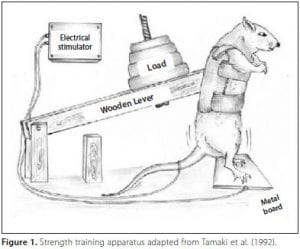One of the long debated issues in terms of training is whether muscle growth occurs only through hypertrophy (an increase in muscle size) or if hyperplasia, an actual increase in the number of muscle fibers. That is, does the number of fast/slow twitch muscle fiber types in your body actually change in response to strength or endurance stimulus? Or just the volume, and you’re stuck with what your genetics dictate?
The short answer is yes-ish.
Here’s the long answer:
Let me make one clarification here. Well, two. The first is that I am talking about skeletal muscle. Cardiac muscle acts a little bit differently in how it grows with stress and we don’t lift weights for a bigger heart. Perhaps if we did there would be more love in the world.
Also, I’m talking about training induced growth. You can cause some goofy stuff to occur when you ablate a muscle (i.e. cut a muscle in a larger group and you see the other muscles grow like crazy) or with other distinctly non-physiological types of research approaches. Here we’re talking about moving iron. Not endurance training, not goofy non-physiological approaches to inducing muscle growth. Just the iron.
Table of Contents
Hyperplasia vs. Hypertrophy: Definitions
First, let’s define the terms hypertrophy and hyperplasia. Hypertrophy means an increase in cell size. Fat cell hypertrophy occurs when the fat cell increases in volume (by storing fatty acids as triglyceride) and skeletal muscle hypertrophy occurs when skeletal muscle increases in volume.
Hyperplasia means an increase in cell number. Fat cell hyperplasia (which does occur in adults, contrary to old belief) is an increase in fat cell number. Skeletal muscle hyperplasia would be an increase in muscle cell, or in this case, fiber number.
The question being asked is whether muscle growth occurs primarily through hypertrophy, muscle fibers/cells growing larger or can the number of fibers/cells increase via hyperplasia. The idea behind the latter would be that, if we could somehow increase the number of muscle fibers and then grow them too, more size could be attained.
Hyperplasia vs. Hypertrophy: Animal Research
Whether or not hyperplasia occurred in animals was debated for many years in the early days of research. I remember an amusing argument between one researcher who claimed to have shown it to occur in animals and another that said he didn’t. I believe it was Gonyea and Dr. Jose Antonio based on the names on the studies I will be linking to.
And they finally addressed it by having one of the graduate students from the lab of the guy who said it didn’t happen go work in the lab of the researcher who said it did. Because what better way to test a hypothesis than to have a guy from the lab that thinks you’re full of crap do your grunt work? If anybody wants to see your hypothesis fail it’s the grad student from the other lab, right?
And by work I mean this: first they put an animal through a training program. In this case it was a cat who was forced to paw at a lever to get food. Over time, the resistance was increased to apply overload (the KEY to muscle growth). Only one arm was trained and then the cat was sacrificed (a nice way of said “killed”) and dissected.
I can’t find a picture of what they did (imagine a cat in a cage with his paw sticking through a hole to paw at a lever) so here’s one of how they do rat squat studies. They actually electroshock their butts to get them to stand up and I think more trainees would have better legs if we did this in the gym. But I also think that putting a shock plate on the back of a treadmill (like they do to study exhaustion in animals) would help folks get their damn cardio done. I digress.
And here’s where the fun started. Because now the graduate student actually manually counted the fibers in the trained versus untrained arms. And we are talking tens of thousands of fibers. This was 1977 and he had to do it by hand under a microscope. Just hand counting endless little muscle fibers. And you think your job sucks.
And voila they did find that fiber number increased. Well that fiber number in the trained arm was higher in any case. It has to be assumed that both arms started with the same number of fibers and that the difference was due to training. It is probably a safe assumption but there’s no way to know for sure in this kind of model.
This is one of the huge methdological issues inherent in doing this kind of work. Ideally you would be able to count the fibers before and after training but you can’t kill the animal twice without some serious necromancy and that means comparing one limb to the other and hoping it’s a good comparison.

Since that time other work has shown rather conclusively that fiber hyperplasia can occur in animals. A common model is the quail stretch model. Here they put a quail wing on constant stretch with a progressively heavier weight. I mean 24 hours a day for 28 days straight. Fiber number increases.
A quick note, this model of training is really nothing like what we do in the gym. I’ve seen folks try to use this type of thing to argue for weighted or chronic stretch in humans but stretching a bird wing for 4 weeks straight is not doing a few minutes of stretching or whatever. It just doesn’t work in humans.
So, at least in a couple of animal models, hyperplasia would seem to be occurring although do note that some still feel that this is only an artifact of measurement and isn’t occurring. The debate continues.
Hyperplasia vs. Hypertrophy: Human Research
Ok, so hyperplasia certainly seems to occur in animals, at least under certain situations. And in that humans are animals (which is why we do it like they do it on Discovery Channel) this would suggest that it can at least occur. But does it?
One early study was at least suggestive. Done in high level bodybuilders, it actually found that they had NO LARGER muscle fibers than untrained individuals. But they had more total fibers. I cannot begin to find this paper right now so you’ll have to take it on faith that it exists.
This kind of fails the reality check, how can guys who train (and trust me, they studied guys in the 80’s so there were drugs involved) that much not have larger muscle fibers? One suggestion was perhaps that great bodybuilders are born with more but smaller fibers and they simply grow to normal size with training. But that’s just purely speculation. I find it unlikely.
Tangent: I’d note that at least one other study found that, enzymatically at least, bodybuilders muscles were more like endurance athletes than anything else (powerlifters and Olympic lifters had muscles that looked like strength athletes) and this is cited somewhere in my Ketogenic Diet book. But guys in that era trained with moderate reps and short rest periods which is really an endurance type of training. But I’m off track.
But what about direct work, has it shown hyperplasia to occur in humans due to training? And that’s a much more difficult question to answer although primarily for methodological reasons. Clearly the cat models can’t be repeated in humans, you can’t train one arm of a human, sacrifice them (although perhaps Cthulu, who is a monster squtter, might help with this) and then count the fibers. This leaves far less direct methods and the common one is to take a muscle biopsy.

When you look into the squat rack, yea verily, the squat rack looks into you.
Muscle Biopsies
I’ve talked about this in a previous article but it basically entails cutting a small chunk of muscle out and then looking at it for various things (ONLY click me if you have a strong stomach). They use this to study glycogen depletion, enzyme changes and you can kind of use it to count fibers.
Basically what you’re getting is part of a fiber and you can look at the end and count the fibers. And what you could do to look at hyperplasia is take a biopsy, train the muscle and take another one and see if the fiber number increases. And this is problematic at best and useless at worst. Imagine taking two small segments of a car and comparing them. Just cut a slice or bit out of it and do it twice and then compare them side by side. The muscle is at least a little bit closer to looking like each other but some weirdness can happen.
Muscle fibers don’t usually run from one end of the muscle to the other, they terminate in what are called fasicles. It’s completely conceivable that a muscle fiber could end at a different point in the muscle than another and this would change the fiber count. Of course, when you’re talking about hundreds or thousands of muscle fibers, this doesn’t mean much.
But at this point there are just enormous methodological issues at work here. Which is not answering the question of whether or not hyperplasia can occur in humans. And some research suggests that it absolutely can. At least one study, looking at the trapezius muscle in powerlifters suggests an increase in fiber number. But they were also using anabolic steroids.
Even here, not everyone is convinced that this is actual hyperplasia being measured and that, rather than fiber splitting (how muscle fibers typically increase in number) it’s actually a defect in fiber regeneration.
It’s interesting that the effects were examined and seen in the traps since the shoulder girdle has particularly high concentrations of androgen receptors. This is why steroids get you ‘yoked’ and there is often a particular “look” in the shoulder girdle of steroid users. FAKE NATTY!!!!
So there’s a big confound here, hyperplasia only seemed to occur in lifters using steroids. Was it the training, the steroids, the combination? Comparisons of steroid and non-steroid users does suggest that this is a steroid effect as hyperplasia, or at least some indirect indicators are NOT found in non-steroid users. So it’s probably a drug effect.
It’s a shame drugs only help a little.
Hyperplasia, Satellite Cells and Myonuclei
I want to expand on this a little since this gets into the potential mechanism of hyperplasia in humans. There are something called satellite cells in muscle. Think of these as pre-muscle cells. When they are recruited or activated, they can turn into new muscle fibers (note: there are also pre-adipocytes, baby fat cells that get recruited to increase fat cell number).
There is something called a myonuclear domain, this is the area or distance that a given nuclei (this is what does things like build proteins) can support. Think of it like the Wi-fi of the muscle, a given hotspot can only send signals so far and then they stop.
To increase the signal, you have to put in another hot spot. This is the equivalent of adding more myonuclei. One known effect of training is to cause at least a short-term increase in myonuclear cell number. For a bunch of reasons I’m not getting into since I’m not up on the current research models, this has the potential to support both larger and more muscle fibers. The increase in nuclei number actually occurs before growth occurs.
There is another interesting tidbit about this. Once they develop, myonuclear cell number hang around for a while. They might actually be permanent. Of course, any new fibers built by hyperplasia probably hang around more or less forever too. And probably explains muscle memory, the rapid regrowth that occurs when you return to training after a long layoff. Since the new nuclei are still there, it’s easier to rebuild the muscle later on.
And here’s the thing: anabolic steroids impact on both statellite cell activation and myonuclear number. Significantly. And this is critically important because the development of both is more or less permanent. Someone can use steroids for a decade and even if they are “clean” for two years (which some federations use to define natural), the steroid user still has an advantage in terms of growth or performance potential. And it’s probably permanent which gives anabolic steroids a PERMANENT advantage over those that have never used.
It’s a shame drugs only help a little.
Hyperplasia vs. Hypertrophy: Summary
So can hyperplasia occur in humans? Most likely, yes. Can it occur without steroid use? That’s more debatable in my mind based on the literature available though I suspect it still happens to a smaller degree.
But here’s the thing. Nothing I’ve ever seen suggests that we can control this very much (except maybe by putting in steroids) through training. If it’s going to happen, it’s going to happen. Some folks have tried to set up training protocols around some of the ways that research has found to either activate satellite cell number or myonuclei number but I’m not convinced we have this much control over it.
Perhaps more importantly, the impact of hyperplasia on overall muscle size is still fairly small. Most of the growth we get from training occurs through hypertrophy no matter how you cut it.
Which is a very, very long way of saying that, yes, hyperplasia probably occurs in humans but don’t worry about it. If it happens it happens and you’re still getting most growth through increases in muscle cell size. If you really want to drive hyperplasia, drugs are more likely to get it to occur than anything you can do in the gym anyhow.

Facebook Comments